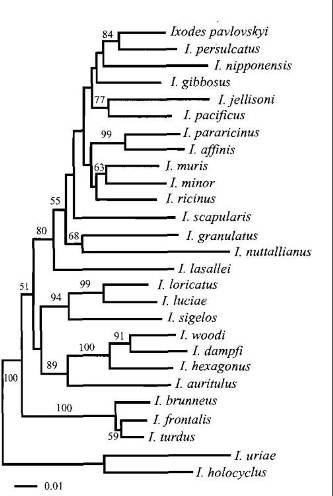
Where I come from..
Taxonomy:
.jpg)
Domain: Eukarya
Kingdom: Animalia
Phylum: Arthropoda
Class: Arachnida
Order: Acari
Family: Ixodidae
Genus : Ixodes
Species: I. scapularis
Eukarya : The American deer tick can be classified under the Eukarya domain
because it is a multicellular species whose cells contain a true nucleus
along with membrane bound organelles.
Animalia: Some characteristics of organisms that are found in the animalia
kingdom are multicellularity, heterotrophic, absence of cell walls, and
exhibit motility. Most organisms under the kingdom animalia reproduce
sexually and do not undergo and alternation of generations.
Arthropoda: This organism can be classified under the phylum arthropoda
because it has a chitinous exoskeleton, segmented body, and
paired and jointed appendages. It is also triploblastic (containing
three tissue layers), coelomate, has a true digestive system, and
grows by molting.
Arachnida: Organisms that fall under the class Arachnida posses four pairs of
legs. Along with this, they have two additional pairs of appendages
that have been adapted for feeding, defense, reproduction and
sensory perception. The absence of wings and antennae are a clear
difference from insects. Their bodies are organized into two
segments, the cephalothorax and abdomen. Most arachnids are
terrestrial and have adapted to their habitat by aquiring internal
respiration.
Acari: Those found under the order Acari possess hypostome with rutella or
corniculi that was formed by palpcoxal endites medially fusing. They
aquire a hexapod larval stage. Lastly, they no longer show a distinct
opisthosomal segmentation.
Ixodidae: Organisms found in the family Ixodidae will share characteristics such
as having a prominent, hard, sclerotized scutum that covers the
anterior end of the female's dorsum. In males this scutum completely
covers their dorsum. In both female and males the palpal article IV is
reduced and buried in the cavity of article III. Another way to
determine an organism from the family Ixodidae is the the wrinkles
covering the integument, however the wrinkles will not be found in the
area of their sclerotized plates.
Ixodes: Organisms found in the genus Ixodes have anal grooves that always
curve anterior to the anus and possess a hard body. They are not equipped with eyes but do possess sclerotized plates. They are not host specific and therefore fed on a variety of hosts. The male does not feed and are considered to be non-feeding. The larva have some specific characteristics as well being the fact that they have two pairs of post-hypostomal setae. Most ticks in this genus transmit pathogenic bacterium Borrelia burgdorferi which normally results in the host acquiring Lyme disease.
I. scapularis
Latin meaning: The word "Ixodes" means hard tick.
For more information on tick taxonomy click here
 |
The phylogenic tree above was constructed using molecular data based on small subunit ribosomal RNA gene sequences to further separate organisms found in the domain Eukarya. This phylogenic tree demonstrates the overall evolution of Eukaryotes from prokaryotes and bacteria. Eukaryotes can be defined by many features that are different from prokaryotes. Eukaryotes have an endomembrane system, are larger in size, possess chromosomes that are multiple and linear where as prokaryote’s chromosomes are singular and arranged in a circle. Another difference between the two is their means of reproduction, prokaryotes reproduce with means of fission and eukaryotes undergo mitosis. The Supergroups were constructed using molecular data, morphological characteristics and inter-Supergroup relationships. The tree starts with the five Supergroups of eukaryotes, Excavata, Chromalveolata, Rhizaria, Archeaplastida, and Unikonta. From there it is broken down into the Superlineages and Lineages. Each Lineage has specific characteristics that require it to break off of the Supergroup into more specific groups. From the Supergroups, Lineages and Superlineages evolve. You can follow the path from the Supergroup Unikonta to the Superlinage labeled Opisthokonts which then breaks into the animal lineage.
 |
This phylogenic tree is much more specific to the organism of interest. This tree is broken down into characteristics that separate a majority of the species in the genus Ixodes. This phylogenic tree was based on molecular based observations with the NJ method using PAUP. This tree shows the relationship and/or differences between Ixodes Scapularis and other species under the genus Ixodes.
To learn more about where I live click here
To Main Page